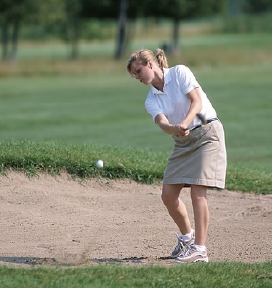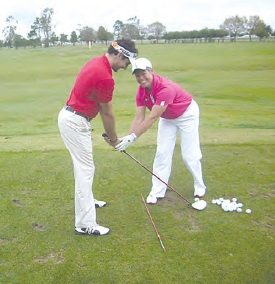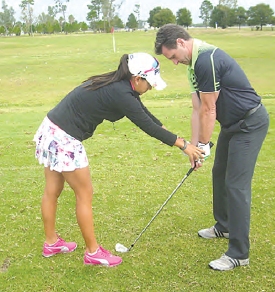Women Teaching Golf: Finding Joy In A Specialized Niche
 As with any profession, golf instruction is replete with individuals who find their way there in innumerable ways. For some, it’s a goal-oriented pursuit decided definitively at a young age; for others, it represents a later-in-life career choice predicated on a desire to be immersed in the sport they’ve grown to love, with the added gratification of directing their talents toward others. For all golf teachers, the satisfaction lies in making a difference for each student, all the while helping to grow the game.
As with any profession, golf instruction is replete with individuals who find their way there in innumerable ways. For some, it’s a goal-oriented pursuit decided definitively at a young age; for others, it represents a later-in-life career choice predicated on a desire to be immersed in the sport they’ve grown to love, with the added gratification of directing their talents toward others. For all golf teachers, the satisfaction lies in making a difference for each student, all the while helping to grow the game.
Female golf instructors follow this pattern just as males do, in the respect that they choose their paths in a myriad of ways. There exists no formula for acquiring the uncommon passion and dedication that comprise the paramount qualities of an exceptional golf teacher. Nonetheless, hurdles may remain for women who select this profession as their life’s work. Some people experience an element of surprise when they encounter a vibrant and successful female golf instructor, although most soon come to understand that excellence is the great equalizer.
“Forget gender; just be the best,” says Jenny Brock, USGTF Level III teaching professional and Level II certified First Tee Coach. “Confidence without competence is arrogance. Prepare well, earn respect from others because of your abilities, and give the kind of lesson that makes students anxious to come back for the next one.”
A USGTF member since 2006, Brock is the head coach of The First Tee at Johnson City, Tennessee. Facilities where she teaches include Elizabethton GC, Pine Oaks GC, Blackthorn GC, and others. In 2012, she relinquished her private teaching practice and now works exclusively in The First Tee program, which she says is a great fit for her. Prior to this move, she had focused her teaching on beginning golfers, particularly women and youth.
“When I retired from the education and business world in 2001,” Brock says, “I had an opportunity to fine-tune my lifelong passion for the game of golf. Teaching was in my heart, and my profession as a physical educator and exercise physiologist gave me a basis on which to build a knowledgeable golf expertise.”
Brock looked for an organization where she could develop proficiency in golf teaching, and found the USGTF. As she already knew many people in her community, her practice grew quickly. Her commitment to The First Tee allows her to work with youth in both golf and character development, while leaving enough time to play competitively occasionally. She engages in tournament play for charity and for promoting the game. And she competed in the 2013 United States Golf
Teachers Cup in Tunica, Mississippi, winning the women’s division. “It was a great experience,” says Brock.
Brock does not believe that the gender issue has been a negative in her practice. She contends that golfers seek her out because she is a good teacher, communicator, and coach. “My students tell my story best,” she says.
 In Brock’s view, in addition to being a devoted golf instructor, supporting the community in other ways is important, too. She is a member of several community boards and now serves in an elected position as a city commissioner in Johnson City, “…a town of 65,000 potential golfers!”
In Brock’s view, in addition to being a devoted golf instructor, supporting the community in other ways is important, too. She is a member of several community boards and now serves in an elected position as a city commissioner in Johnson City, “…a town of 65,000 potential golfers!”
Effective teaching techniques Brock uses include working with students at their own levels, drawing on other experiences they may have had, focusing on the positive, and emphasizing golf as a lifelong activity. “Every day I demonstrate that I am a senior and a woman in my seventies who still can play,” says Brock. “I let my passion for the game shine through with each encounter.”
Gale James, USGTF Master Golf Teaching Professional, was introduced to golf in an unusual way. After her mother’s death, James decided to try her physician’s prescription: hitting golf balls as “therapy.” With only a 7-iron in hand, Gale could be seen at Westchester Golf Course in Los Angeles most evenings. After several months, she was hitting the ball straight, in the air, 135 yards out. When local golfers at the range asked her why she had only one club, she would chuckle and reply, “Oh, I don’t play golf. I don’t know anything about golf. I’m just out here for therapy – doctor’s orders.”
Many players, including some golf professionals she met, encouraged James to learn more about the game. Inspired by their encouragement, she became curious to see if she could learn to play. Soon thereafter, she began playing par-3 courses. In 1989, she was invited to become a member of Western States Golf Association’s Golden Tees Golf Club. With the help and support of club members, and after winning her first tournament, it was full steam ahead. Gale, a USGTF member since 2002, now is well known around California golf links, from San Diego to Sacramento. During her 15 years as an amateur, she won a host of trophies and awards in championship tournaments, including the Los Angeles City Championships, where she as a two-time 1st Flight winner. These days, James is not as competitive as she once was.
“After becoming a certified golf instructor,” says James, “…my focus shifted from being a serious competitive player to a teacher, coach, and mentor, with a passion that exceeds any other I’ve ever accomplished.” The success James has achieved has not come without challenges. Early on, she encountered resistance by some golf professionals in positions of authority as she sought a teaching position.
“I was disappointed and almost let my dreams and aspirations of becoming a golf instructor go out the window,” James says. “I am so glad I did not, and I found the USGTF, where I was accepted and earned my Master IV Level accreditation. The USGTF program offered me an open door into the golf teaching profession, an opportunity I may have never been given.”
James asserts that being a female instructor has not been a deterrent. She feels blessed to have a second career she enjoys and feels passionate about. Her patience with students and determination to help them be the best they can be at the game have brought her rave reviews as a professional golf instructor, as an independent contractor, at Chester Washington Golf Course in L.A.
“I have earned the success I am enjoying through hard work and education, and by propelling my students on to their own success,” she says.
 Kathy Hester, USGTF Level III instructor and also an LPGA Class A member since 2002, did not learn to play golf until she was 26 years old. After having played amateur golf for about 10 years and having competed at a high level, she decided one day that she had studied the game enough and became an accomplished-enough player that she had reached the point where she could teach others to play. A USGTF member since 1992, Hester is the owner of Kathy Hester’s On Target olf
Kathy Hester, USGTF Level III instructor and also an LPGA Class A member since 2002, did not learn to play golf until she was 26 years old. After having played amateur golf for about 10 years and having competed at a high level, she decided one day that she had studied the game enough and became an accomplished-enough player that she had reached the point where she could teach others to play. A USGTF member since 1992, Hester is the owner of Kathy Hester’s On Target olf
Center of Vicksburg in Vicksburg, Mississippi, with four locations. Although she believes that golf has not yet made a comeback since the start of its downward spiral in 2007, she does as much as she can to create new golfers and keep them involved.
“I have just installed golf in the home schools in Mississippi,” Hester says. “This is creating a lot of new people. I am allowing the parents to attend the classes and learn right along with the students. It is working very well!” Hester also hosted two free women’s clinics this past summer, at different locations, attracting some new golfers with this strategy.
Hester’s decision to strike out on her own as an independent golf instructor was predicated on the resistance she experienced in landing a full-time head professional position at a course where she had been an assistant. Today, she enjoys her role as owner of her own golf school and appreciates the difference she is making for a lot of players.
“I love teaching the game of golf,” says Hester. “I don’t want to do anything else.”
An advantage of being a female golf instructor, Hester says, is patience, an important quality which many players believe women instructors possess in greater abundance than men do. Also, she says, women often are perceived as being less intimidating. And since women don’t try to overpower the ball, the swing is a lot smoother for students to look at, she asserts. One of Hester’s current students is a young man, age 25, who recently returned from military service in Afghanistan, and who had taken lessons from Hester when he was 16. He attributes his rapid improvement now to her excellent instruction in correctly gripping a club and learning how to use his wrists properly.
“The most important thing,” Hester says, “is to make sure students know you care about them and whether they get better or not. Don’t always tell them what they are doing wrong. Just show them ways to do it better.”
For Alice Brown, a USGTF member since 2011, the path to a golf teaching career emerged from a desire to compete at the highest levels. Having qualified for the Duramed Futures Tour (now the Symetra Tour) in 2008 for the 2009 season, Brown was struggling financially to afford all that tour play entails. She gave up her full-time career as a salon owner, choosing to work in a salon by appointment only. Her golf game was not at its peak, and she found that some of her instructors were not sufficiently detailed in their work with her. Knowing she needed to be more knowledgeable and skillful, Brown decided to learn how to teach golf, finding another source of income as a result. She considers Jim Dent Sr., Andy Bean, and the late Julius Richardson as her mentors. Having begun teaching in 2009, Brown believes that her competitive play has given her special perspective as an instructor at Ace Golf in Brandon, Florida.
“I can actually give my students a little more insight on what to expect in competition,” says Brown, “such as how to practice, what to practice, how to dress, mentally what you should be thinking, diet, numbers, wind, and so on. These are things that average golfers don’t think about.”
In looking back, Brown sees obstacles she had to overcome on her journey toward becoming a golf teacher, not only as a female, but specifically as an African- American female.
“There aren’t many of us,” says Brown. “My story is that when I first started, and still sometimes today, I have to continuously prove myself. I get the ‘Let me see if she knows what she’s talking about,’ and then I get the ‘Wow, you really know what you are talking about,’ and then I get ‘That’s impressive.’”
Brown can identify the turning point in her teaching career. One day, one of the other golf instructors was on the range, having lost something in his swing that he couldn’t get back at the moment. She asked what was wrong; he replied that he couldn’t seem to get his trajectory right and kept hitting a low hook. Brown identified the problem within seconds. Customers saw her working with him on the range and became interested.
“My level of confidence is very high as a golf instructor,” Brown says. “When people feel a positive spirit, they somehow always seem to find their way to me eventually. The instructors at Ace Golf are professionals, and we are very loyal to each other.”
One challenge Brown experiences these days is one of equality. She thinks men are afraid to take lessons from a female golf instructor, “…maybe because of what other men think. But if it works, who cares?”
One of Brown’s memorable teaching successes was working with a special-needs student and seeing him get the ball airborne for the first time.
“The smile on his face, as well as on his parents’ faces, was priceless,” says Brown, who advises young women who love golf and teaching to pursue a career as an instructor. “Go for it,” she says. “It can only enhance your game; it will definitely take it to another level. More knowledge, more success.”
Pat Church, USGTF Hall of Fame member, had the good fortune to grow up immersed in the game. Her father was a golf instructor and pro shop manager at New Orleans Country Club in the 1960s and ’70s. Church spent many a non-school day at the course with him, watching and learning from him and other teachers. “I stayed active in golf all my life,” says Church, a USGTF member since 2004, “but when I became unemployed in 2003, I came back to the game I love, and as they say, the rest is history.”
Church is the Women’s Club coordinator, Special Olympics Golf head coach, and The First Tee coach at RiverRidge Golf Complex in Eugene, Ore. She believes that her frequent play, as a 12-handicapper, keeps her in touch with the struggles of all golfers. She usually plays with the Women’s Club and Senior Men’s Club at her golf course, allowing players to see her game in all its flux. Many seek to take lessons from her.
“As a female instructor, I have experienced golfers wanting to learn from a man rather than from me, but I don’t take it personally,” Church says. “All of the other instructors at our complex are men, but we are a tight-knit group. We are all willing to help each other and all of our students. I have not experienced any roadblocks in any of my ambitions.”
 Church believes all instructors face a common challenge: the decline of players in our game. Since RiverRidge has the teaching contract with the University of Oregon and Lane Community College for their recreational golf classes, Church has many chances to introduce new students to golf. Many of the males in these classes show some disappointment in having a female instructor, Church says, until they watch her swing and listen to her advice…at which point they quickly change their tune. A few of the University of Oregon football Ducks have been in her class, including Heisman Trophy hopeful quarterback Marcus Mariota.
Church believes all instructors face a common challenge: the decline of players in our game. Since RiverRidge has the teaching contract with the University of Oregon and Lane Community College for their recreational golf classes, Church has many chances to introduce new students to golf. Many of the males in these classes show some disappointment in having a female instructor, Church says, until they watch her swing and listen to her advice…at which point they quickly change their tune. A few of the University of Oregon football Ducks have been in her class, including Heisman Trophy hopeful quarterback Marcus Mariota.
Of all the successful teaching techniques Church has acquired through the years, the most effective, she thinks, is being a good listener, something she learned from her father. As no two golfers are alike, it follows that no two lessons can be alike. Each student comes with his or her own set of challenges. Church advises her colleagues never to be afraid to ask for a second opinion from another teacher. Most students will appreciate this quality. To her younger teaching counterparts, Church counsels: “Be yourself. If you love the game, show it by sharing your joy with all. Don’t do it for the money; do it for the joy and pleasure you receive in return, especially if you become a Special Olympics coach!” Church believes golf is in decline due to several
factors: the slow economy, time needed to play and practice, stuffiness, and the game’s mystique.
“I can’t do anything about the economy,” says Church, a 2014 USGTF Hall of Fame inductee, “but I can help demystify the game and make it more fun – especially for the women and juniors I teach. I enjoy seeing the young girls I teach now have the opportunity to play golf in high school, college, and beyond. My favorite line to them is, ‘Someday I’ll want to retire and YOU could be filling my shoes!’ This is my greatest enjoyment…watching young girls not be discouraged from becoming what they want to be and helping them find the joy I have found in golf.”




